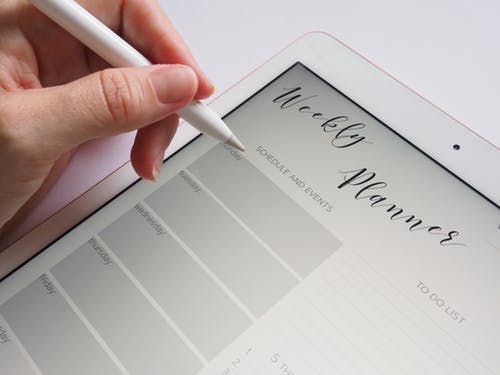What’s the point of tracking your productivity? Hey, if you don’t know how fast you are moving, there is no way to get faster. The main reason to monitor your productivity is to find out where you may want to improve, and in what way you might choose to change. Tracking keeps you focused on your goal, makes you more efficient, and helps you maintain a healthy balance. Keeping track also ensures that you’re working smarter, not harder.
Finding out when you’re most productive has some serious benefits. You’ll also want to know where you work the best — in order to hit peak production times. But, how can you find out your personal production peaks? Here are six ways you can find out how you are doing and where you are headed.
1. Time logs: The simple way to identify your peak productivity hour.
Believe it or not, it’s really not that difficult to track your personal productivity peaks. You just need a pen and a journal. Your Calendar is also a great place to keep track. Yep. It’s really that simple.
Of course, there are more steps involved here. But, it’s still the most straightforward method you can use to track how you’re spending your time.
- Pick a day and mark it in your calendar to start tracking your time. Just begin — or you’ll never make this commitment.
- List everything that happened during the day from when you wake-up to bedtime.
- Take into account factors that may impact your energy. Examples could be drinking coffee or being kept up all night because your toddler is teething.
- Record everything that you’ve accomplished in an hour. Ideally, you want to rate your performance on motivation, focus, and energy level.
- When you have some downtime, like during a break or at the end of the day, reflect on what you’ve done. The reason? You want to pick-up any patterns. For example, are you more energetic in the morning or afternoon? What times do you usually get distracted? When do you feel like you’re ready to go or need a rest?
How long should you keep a time log? For some, a week is sufficient. But, if you want a more accurate finding, the longer the better. Usually around a month is more than enough. However, some people prefer to track their time for up to three months.
If you want to get more in-depth, here some other suggestions you can try when tracking your time.
- Experiment. Maybe wake-up an hour earlier or sleep-in. Switch tasks around in your schedule. Take longer breaks, meditate, exercise, and alter your caffeine intake. All of these can influence your energy levels.
- Wake-up and fall asleep naturally — that means no alarm clock.
- Be aware of your ecosystem. “What this means is that the bedtime routine you have with your 2-year-old is going to possibly affect your performance in your 8 am meeting the next day,” explains Vanessa Kettner, a coach with Personal Best. “Or that traumatic 4 pm deadline you had every day in that job ten years ago might still be exercising its influence today.”
- Check your temperature. Don’t worry; this has nothing to do with COVID-19. Our body temperatures drop when we’re tired. So, record these fluctuations throughout the day to give you a better idea of energetic peaks and lulls.
- Make use of time and activity tracking apps. Most of these tools, like RescueTime and Toggl, run in the background of your computer or smartphone. They then track the time you spend on apps, websites, and projects so that you have a report on how you’re spending your time online.
2. Work with your Ultradian Rhythms.
If there was one pattern that I hoped you noticed while tracking your time, it’s when you have bursts of energy. For example, you may be most productive for an hour or so before crashing. That’s because of biological cycles called ultradian rhythms.
“Ultradian rhythms have been made famous primarily through a sleep study,” explains Wanda Thibodeaux over at Inc.com. “The ‘father of sleep,’ sleep researcher Nathaniel Kleitman, figured out that people go through ultradian cycles whenever they get some shuteye.”
However, Kleitman also “discovered rapid eye movement (REM) and proposed that sleep included active brain processes.” He “also discovered that a Basic Rest Activity Cycle (BRAC) is present when people are awake, too,” writes Thibodeaux. “Generally, these daily ultradian cycles involve alternating periods of high-frequency brain activity (about 90 minutes) followed by lower-frequency brain activity (about 20 minutes).”
I don’t want to overwhelm you with too much science here. But, here’s the gist. When you track your time, you should be able to pick-up on these cycles.
Instead of fighting against them, use your ultradian rhythms to your advantage. Using any pattern or rhythm means spending those periods of high-frequency brain activity on your most challenging and essential tasks. For example, if your most wide-awake, alert time of day is between 9 am, and 10:30 am, then block that timeframe out for your top priority of the day.
As for the periods of lower-frequency brain activity? Those 20-minute blocks should be spent on activities that either don’t exhaust too much energy or help you recharge. Examples would be cleaning out your inbox, going for a walk outside, reflecting, or preparing for your next meeting.
3. Calculate your “Biological Prime Time.”
Coined by Sam Carpenter in his book Work the System, your “biological prime time,” as defined by Chris Baily, “is the time of the day when you have the most energy, and therefore the greatest potential to be productive.”
Obviously, your highest potential energy time is likely linked to your ultradian rhythms. But, you’re going to use a more systemic approach to calculate what your biological prime time (BPT) is.
To calculate his BPT, Baily charted his “energy, focus, and motivation levels for 21 days between the hours of 6 am and 9 pm.” Baily explains, “To control for any extraneous variables, I didn’t consume any caffeine or alcohol, worked out at different times every day, and woke up and fell asleep naturally.”
“My specific results aren’t too important, simply because yours will vary so much depending on your biology,” writes Baily. “But there are huge productivity benefits to charting your energy levels throughout a typical day.”
Likely the easiest and quickest method here is to use the time log method here. The key difference is that you’ll want to use a spreadsheet.
“From the moment you either wake up, or start working (it’s up to you), start tracking your Energy, Focus, Motivation, and Creativity on the hour, every hour,” writes Rob Nightengale for Make Use Of. “Set an alarm to remind yourself to do this. It should only take around 20–30 seconds per hour.”
“If you decide to only track from 9 am, you can leave the entries before 9 am blank,” adds Nightengale. “The same goes if you stop tracking at 5 pm.” With that in mind, “do try to only track during the same times each day. Otherwise, the data could be skewed.”
After that, it’s pretty simple. Just give yourself a score in “how you’re feeling in each area out of 10,” adds Nightengale. “Be completely honest with yourself here, and don’t fall victim to the Hawthorne Effect, where you may feel tempted to increase your scores just to make yourself feel better.”
“As you start inputting data, you’ll see the Totals and Average column will fill automatically,” Nightengale continues. “As will their respective tables and graphs on the right-hand side. You don’t need to touch these.”
Keep in mind though that if you only track 5 days instead of 7, “you will have to change the formula in the Average column to divide by 5 instead of 7.”
“By charting your energy levels (and focus and motivation levels, if you’re curious), you can schedule each day’s tasks based on when you have the most energy, focus, and motivation, and plan your entire day accordingly,” states Baily. “You can also visually see interesting trends in your day, like how much of a morning bird or night owl you are.”
If you don’t want to create a spreadsheet from scratch, Nightengale has been awesome enough to do the legwork for you. In other words, he’s created it for you, and you can download the Prime Time Calculator Spreadsheet here.
4. Follow the peak, trough, recovery cycle.
According to Daniel Pink, author of When: The Scientific Secrets of Perfect Timing, we tend to through three predictable stages throughout the day; a peak, a trough, a recovery. Even without tracking your time or calculating your biological primetime, you probably already have some idea of these patterns.
But, let’s explore what they are in a little more detail.
The first stage is the peak. “Research shows we should be doing our analytic work during the peak, Pink told Sheryl Sandberg during a Facebook Live book discussion. “That is work that requires heads-down focus, attention, the keyword: vigilance,” he said. “Can you bat away the distractions?”
A trough is where our energy becomes limited. As such, this is when we make more mistakes. “What we should be doing during then is our administrative work: routine emails, all the variations of garbage we have to do in the course of the day,” Pink advises.
The lower production time is followed by a recovery where we feel re-energized. “We have a rising mood, which is good, but we’re less vigilant. It’s a good time for the creative work such as brainstorming, things where you need to be a little looser,” Pink stated.
Most individuals will move in that order. The exception is if you’re a strong night owl. If you are a night owl — the process is reversed.
These patterns are different for everyone. But, research from Priceonomics shows “that most people don’t really get going until 7 AM (a typical start time), and that after 5 PM (typical finish time), work quickly tapers.” What’s more, for most of us, our most productive time of day is 11 am, and it drops after lunch.
5. Match your work to your mental energy.
If you’re still trying to track your personal production peaks, then here’s a technique that Trent Hamm, founder of The Simple Dollar, has used:
Make an energy map of your days.
“Fire up your favorite spreadsheet program and open up a weekly planner spreadsheet, one that has the days along the top and the times along the left, split up into fifteen-minute or half-hour increments or so,” he writes. “Print off several of these (so that they’ll travel with you easily)”.
Now, you’ll just want to “keep it on your desk where you’ll notice it all the time.” The catch? Don’t use it for planning. Instead, “write in what you’re doing and use a number to describe how productive you feel, with a 10 being as productive as you possibly can be and 0 being asleep.”
After a couple of weeks, you should have some visual data on your natural energy levels.
Since you know when you’re most productive, Hamm suggests that you manage your energy by:
- Cataloging all of your routine tasks. The idea is to identify “which of your regular tasks require focus and concentration and which ones do not.”
- Making a rough framework schedule of your upcoming week the week before. Like Trent, I do this on Fridays. But, you can do this during the weekend if you prefer. Just make sure that you list all of your priorities and assign them to a specific day.
- Tighten up the framework the day before. “Each evening, I make a plan for what I intend to do the following day,” writes Hamm. “Since I already have a general list of the stuff I want to accomplish from my weekly plan, I just organize those items in an order that takes advantage of the natural ebb and flow of my energy throughout a given day.”
- Make “appointments” for specific tasks. For your vital tasks, schedule an exact time to focus on them. For Trent, that was writing his book. “8 AM, every day, one hour, then 10:30 AM, every day, a half an hour,” he writes. “This allowed me to make steady progress going forward, first with a detailed outline of the book, then filling in the pieces as I went.”
- Don’t force yourself to work through an energy valley. Even if you’re in the middle of something important, it’s best to stop and take a breather so that you can recharge.
6. Use your calendar as a self-tracking tool.
Even if you don’t live and breathe by your calendar, it can still come in handy in helping you figure out when you were most productive. For instance, if you reviewed last year’s calendar, you may have noticed some patterns. Did meetings occur at specific times? If so, what was the reasoning? Did you tackle a large project? How did you break it down? And, how long did it take you to complete each part?
How do you look up past data? Well, I recommend you check out this previous Calendar post from Abby Miller that lays out the process.
Even more promising? Online calendars continue to evolve; they’re becoming more intelligent. Take Calendar as an example. It uses machine learning to make smart suggestions on how you should spend your time and schedule events by using historical data.
Final words of advice.
After tracking your personal production peaks, manage them properly. That means reserving your most challenging or important tasks during your highest peaks. As for the activities that don’t require as much energy? Save them during lulls.
Most importantly, protect your time by saying “no” more often, single-tasking, and taking care of your health and well-being.








